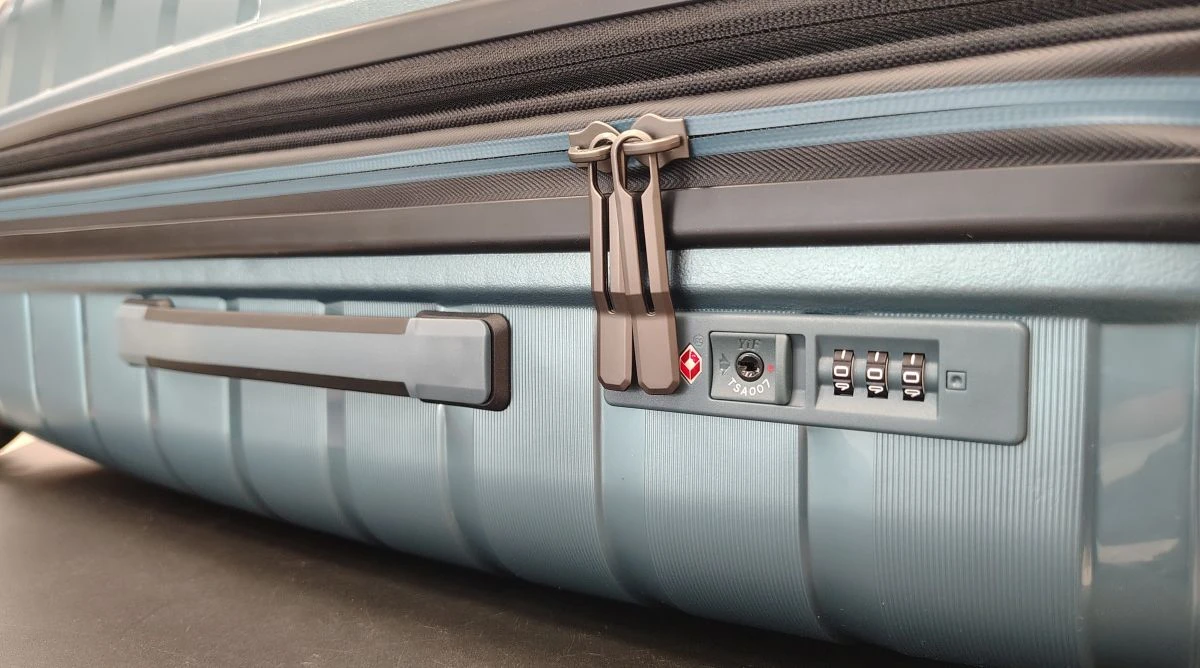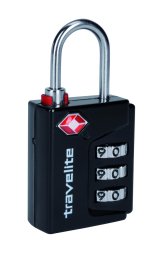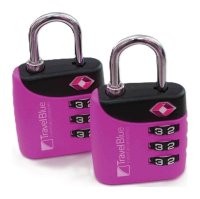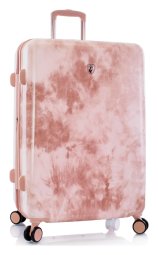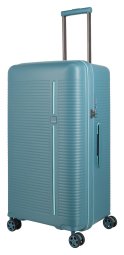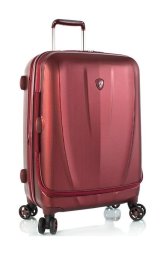Are you getting ready for a vacation or a business trip and the final preparations are underway? Packing is almost done, and only one thing remains – to correctly set the lock and securely lock your suitcase. For some, it's a routine; for others, a puzzle. Whether you have a new suitcase with a TSA lock or have purchased a separate padlock, proper setup is key to protecting your luggage.
No worries, it's not rocket science. In this comprehensive guide, we will walk you through the setup of common types of locks step by step. We will show you how to handle a built-in TSA lock, how to deal with a combination padlock, and what to do in the unpleasant situation of forgetting your numerical code. Let's get to it, so you can travel with a clear mind!
Contents:
- What is a TSA lock and why is it standard today?
- How to Set a Suitcase Lock: Guides for Setting More Than Just TSA Locks
- Troubleshooting: What to do when...
- Bonus Tips for Worry-Free Travel
- Frequently Asked Questions When Setting a Combination Lock on a Travel Suitcase
- Travel with Proper Security
What is a TSA lock and why is it standard today?
Before we get into the setup itself, let's take a moment to explain what this mysterious TSA lock actually is. If you've recently bought a travel suitcase, you've probably come across this acronym. The acronym TSA comes from the English name of the U.S. government organization, the Transportation Security Administration.
This agency was created after the events of September 11, 2001, with the aim of increasing security at airports worldwide, especially in the USA, Canada, Australia, and increasingly in Europe and Asia. Security officers have the right to randomly inspect the contents of any piece of luggage.
And this is where the advantage of a TSA lock comes in. It allows airport security personnel to safely open your suitcase using a special universal key without damaging the lock or the suitcase itself. After the inspection, the luggage is locked again and can safely continue on its journey. If you had a classic lock, the security check would mercilessly cut it.
Tip: In a separate article, we cover TSA locks in even more detail. If you really want to delve into their secrets, don't hesitate to read it!
How do you recognize TSA locks?
It's simple. Every TSA lock, whether built-in or a padlock, is marked with a logo in the shape of a red diamond. This symbol gives security personnel a clear signal that such a lock can be opened without damage. Purchasing a TSA lock is therefore an investment in peace of mind and the assurance that your luggage will arrive at its destination intact.
How to Set a Suitcase Lock: Guides for Setting More Than Just TSA Locks
The setup is quick and intuitive. Most travel suitcases are set from the factory to the original code 0-0-0. We will be working with this combination. The procedures vary slightly depending on the type of lock your suitcase has.
1. Built-in TSA lock with a reset button
The most common type on modern hardshell and softshell suitcases. The lock is a fixed part of the suitcase's construction, and the zipper pulls click directly into it.
- Unlock the lock with the original code: Make sure the combination on the dial is set to 0-0-0. Press the main button to release the zipper pulls.
- Find and press the reset button: Look for a small, recessed button next to the dial. You will need a thin object to press it, ideally the tip of a pen. Press it until you hear a distinct click. The button will stay depressed.
- Set your own combination: Now, choose your new, personal three-digit code.
- Confirm the new code: To save the new combination, press the main opening button again. The small reset button will return to its original position, and you will hear another click.
- Verify functionality: Before locking the suitcase, turn the dials several times, try to open the lock, and then set your new code and verify that everything works as it should.
2. Separate (padlock) TSA lock
A separate lock is a great option for luggage that does not have an integrated lock, or as additional security for, for example, sports bags or travel backpacks. The principle of setting a combination lock is very similar.
- Open the lock with the original code: Again, make sure the code is set to 0-0-0 and pull out the shackle (the metal loop) of the lock.
- Prepare the lock for setting a new combination: On most TSA padlocks, you need to turn the open shackle 90 or 180 degrees (depending on the specific model and brand) and push it down. The shackle must remain pressed down throughout the setting process.
- Choose your new personal code: While holding the shackle down, set your new, unique numerical combination on the dials. Be careful not to accidentally move the dials you have already set.
- Save the new code: Once you are done, simply pull the shackle up, return it to its original position, and your new code is set!
- Test: Before you lock the suitcase, try locking and unlocking it several times with the new code. This will prevent an unpleasant surprise at the airport in case the code was not saved correctly.
3. TSA lock without a reset button
On TSA locks that do not have a separate reset button, the main unlocking button is used to change the code. The lock is factory set to 0-0-0. The most important thing is that the zipper pulls are not inserted into the lock during the setup, otherwise there is a risk of irreversible damage.
- Set the valid code (factory set to 0-0-0).
- Press and hold the main unlocking button.
- While holding the button, choose your new combination on the dials.
- Release the button – the new code is now set and saved.
4. TSA lock with a steel cable
This type of lock allows you to secure not only the zipper pulls but also the entire suitcase to a fixed object using the integrated cable. The lock is factory set to the code 0-0-0. Before changing the code, always make sure that the zipper pulls and the end of the cable are pulled out of the lock to avoid damage.
- Set the valid code (factory set to 0-0-0).
- Using a pen, press the recessed reset button until you hear a click.
- Set your new, arbitrary combination on the dials.
- Press the main unlocking button – the reset button will return to its original position, and the new code is saved.
Note: The steel cable is unlocked with the same numerical combination, but it is released by pressing a separate button (often marked with the word "cable").
5. Clasp TSA lock (on frame suitcases)
On frame suitcases, which close with clasps instead of a zipper, the procedure for setting the code is different. The change is made on the inside of the lock after it has been opened.
- Open the clasp by setting the valid code (0-0-0) and pressing the unlocking button.
- On the inside of the open lock, find a small lever or sliding button.
- Switch this lever from the OFF position to the SET position.
- Choose your new, arbitrary combination on the dials.
- Return the lever to its original OFF position – this saves the new code and makes it active.
6. Double clasp TSA lock
Some frame suitcases are equipped with a system of two separate TSA locks for maximum security. A different code can be set on each, but for simplicity and easy memorization, we recommend setting the same combination on both locks.
- Open both locks by setting the valid code (factory set to 0-0-0).
- On the inside of one lock, find the reset lever and switch it from the OFF position to the SET position.
- Choose your new, arbitrary combination on the dials.
- Return the reset lever to the OFF position – the new code is now saved.
- Repeat the procedure for the second lock. Your new combination is now active.
7. Combination lock (without TSA)
Changing the code on a standard combination lock that is not equipped with a TSA function is a matter of moments. During the setup, the dials may be stiff to turn – this is a safety feature against accidental changes.
- Open the lock with the valid code (e.g., 0-0-0).
- Press and hold the small button for changing the code (it is often recessed).
- While holding the button, set your own combination on the dials.
- Releasing the button saves the new code, and it is immediately valid.
Troubleshooting: What to do when...
...you forget the code?
It happens. Before you reach for a crowbar, try this method:
- Systematically try all combinations from 0-0-0 through 0-0-1 to 9-9-9. For a three-digit lock, this is 1000 combinations, which can take approximately 30–60 minutes. Put on your favorite podcast and treat it as a form of meditation.
...the reset button gets stuck?
If you accidentally press the reset button while the pulls are still latched, the lock will enter "reset mode" and get stuck.
- The only reliable solution is again to try all combinations from 0-0-0 to 9-9-9 and try pressing the main opening button with each. The moment you set the randomly saved code, the mechanism will release. Under no circumstances should you try to pry the button open by force!
Important warning: Avoid internet "hacks"! On the internet and video platforms, you may come across tutorials that promise to open a lock without knowing the code using paper clips, picks, or other "guaranteed" tricks. We strongly advise against them. Modern locks are designed to resist these attempts, and you will almost certainly destroy the entire mechanism with unprofessional manipulation. The only patient, but guaranteed safe method is the systematic trial of all numerical combinations described above.
Bonus Tips for Worry-Free Travel
- Visibly mark your suitcase: Use a colorful luggage tag (name, phone, email), a ribbon on the handle, stickers, or a suitcase cover. This will prevent mix-ups at the airport.
- Save your code: Write down the new combination in your phone's password manager or another safe place.
- Regular check: Before each trip, check that the lock is working correctly.
Frequently Asked Questions When Setting a Combination Lock on a Travel Suitcase
-
How do I set my own code on a combination lock?
Unlock the lock with the original code, press the reset button, enter the new code, and press the button again to confirm. The procedures vary slightly depending on the type of lock. -
What are the types of TSA locks?
There are various types, including built-in and padlocks. You will always recognize them by the red diamond logo. -
Is a TSA lock necessary for carry-on luggage?
It is not a legal requirement, but we strongly recommend it. You will increasingly encounter forced check-in of your suitcase at the gate due to full flight capacity. At that moment, your cabin luggage becomes checked luggage, which risks damage to a regular lock. -
Where can I get a universal key for a TSA lock?
Nowhere. The universal key is a special tool intended exclusively for certified security personnel at airports and is not available for public sale.
Travel with Proper Security
Properly setting the lock on your suitcase is a small but extremely important step towards safe and peaceful travel. Whether you opt for a modern suitcase with a TSA lock or a reliable combination padlock, you now know that setting the code is a matter of minutes. Remember that a TSA lock with the red diamond logo is already a necessity for air travel, protecting both your belongings and the suitcase itself from damage during a security check.
We hope our detailed guide has helped you and that you will set off on your next journey with the feeling of perfectly secured luggage. Travel safely and with ease!

